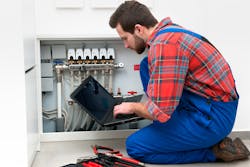Plumbing Technology Trends for 2024
By Ralph P. Sita, Jr.
Thanks to rapid technological advances and the public’s growing interest in adopting many of those changes, the year ahead is likely to see plumbing and hydronic heating companies working harder than ever to keep up with the latest innovations while continuing to offer customers cutting-edge services. What are the top trends in plumbing technology businesses should be prepared to encounter in 2024 and beyond?
Growing Demand for Eco-Friendly Fixtures
It's probably no surprise that one of the biggest trends plumbers will see in the year ahead is an increased demand for eco-friendly plumbing fixtures. With climate issues constantly in the headlines and heating and cooling bills continuing to climb, a growing number of consumers are on the lookout for ways they can save energy while lowering costs.
Most homeowners are at least tangentially aware of issues with water consumption, and many are responding by trying to update their plumbing. As more eco-conscious millennials become homeowners, demand for environmentally friendly fixtures is rising. Harvard's Joint Center for Housing Studies, for example, found that nearly one in three homeowners are planning to retrofit their houses with tankless water heaters. This same trend is responsible for growing consumer interest in solar-powered hot water heaters.
Homeowners are also beginning to install water-saving dishwashers, washing machines, and toilets. Twenty-two percent of homeowners are considering switching to eco-toilets that compost waste matter. Lawn irrigation systems are being exchanged for more eco-friendly options. Some consumers are even choosing to skip the irrigation system altogether, while others are simply opting for carefully timed systems that minimize water waste.
Plumbing as Part of Smart Home Systems
Given the popularity of voice assistants that can turn on the lights or adjust the AC, it was only a matter of time before homeowners started to demand the same level of convenience from their plumbing.
Most smart plumbing today consists of discrete ways to incorporate plumbing into home systems. Smart toilets, for example, typically have automatic flushing features along with heated seats, bidets, and water-tracking features. While still considered a high-end luxury, smart toilet sales are projected to surpass $12.9 billion by 2026.
Homeowners are also showing interest in smart home features such as touchless technology (60% of Americans believe touchless faucets are safer and more hygienic), smart leak detectors which send an alert when they sense a leak, and smart showers that can preheat the shower or run pre-set jet massage cycles. Voice-activated systems, meanwhile, are doing everything from starting a washing machine cycle to controlling the shower temperature.
Incorporating Technology Solutions
The common denominator for all of these innovations is technology. To ensure customer satisfaction, modern plumbers need to do more than provide good plumbing services and competitive pricing. They must also leverage technology to make things as convenient for customers as possible.
More and more customers say they pick their plumbers based on online testimonials, informative websites, and helpful features such as online appointment scheduling. Ninety-eight percent take online reviews into account when choosing a service provider. Given that, companies cannot afford to be without a vibrant online presence designed to generate increased awareness of the firm and showcase both available services and their own successful track record of customer service.
Plumbers are also increasingly employing field service management software to manage all aspects of their business—from work order scheduling, invoicing, and inventory management to estimating and payments processing—and manage customer relationships. Doing so enables companies to streamline back-office operations and reduce paperwork while responding more efficiently to customer inquiries.
Beyond standard day-to-day work, companies in the year ahead must be prepared to respond to rising consumer demands for the latest innovations in convenient and foolproof specialty tools. Infrared technology, for example, allows plumbers to find leaks without destroying walls and conduct camera drainage inspections that quickly identify problems. Trenchless pipe replacement enables sewer system repairs without digging up the entire line. Older plumbing is being replaced by pipes made from materials like PVC or PEX, which are more durable than traditional pipe materials and resistant to corrosion, leaking, and bursting.
Some plumbers are even adopting augmented reality technology, enabling them to diagnose plumbing issues remotely so that they are ready to deal with the problem as soon as they come on-site. And because so many of these tech advances depend on digital networks for communication, technicians must be able to advise customers regarding adequate security measures to prevent computer hacks.
Clearly, the coming year will see even more changes driven by technological advances. Those businesses that are prepared to embrace these new plumbing trends will have more opportunities to meet their customers' needs and ultimately succeed in an increasingly competitive field.
Ralph P. Sita Jr., CPA is a lifetime successful serial entrepreneur. Prior to co-founding FieldBin he co-founded the online cybersecurity learning platform, Cybrary, with over 3 million users. Sita is also CEO and Founder of TrainACE, a brick-and-mortar advanced security computer training company. For more information, visit fieldbin.com.
